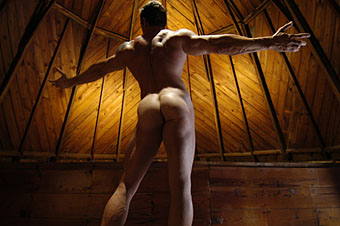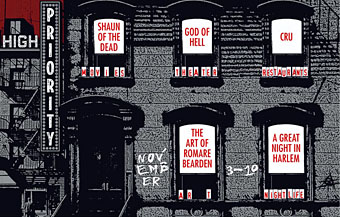The Michelangelo-esque photography of Steven Vaschon.
High Priorities
In which your humble narrator enters a contest…
Speak Up, in collaboration with New York magazine, is proud to announce the first-ever open contest to design the visually acclaimed, graphically exhilarating, by-invitation-only “High Priority” feature illustration in the magazine’s year-end, December 18, 2006 double issue.
High Priority highlights five activities, suggested by New York writers, that are not to be missed. Every week designers and illustrators from around the world are invited to create an interpretive typographic illustration to open “The Week” – the listings section of New York Magazine. New York readers place great weight on these five recommendations, and this page is a regular destination for many.
For examples of past editions of High Priority please visit:
New York‘s High Priority archive
Design Observer’s Variations on a Theme: New York‘s High Priorities
I knew about this listings feature from having read the Design Observer piece (I’ve never seen a copy of New York), and liked the idea for what amounts to the design equivalent of a “standard” in jazz, with different designers having to present a riff on the same brief in each issue. The restrictive nature of the problem is part of its appeal; only two colours are allowed (red and black), the box must be the shape it always is, and the design has to incorporate five categories—Movies, Theater (sic), Art, Nightlife and Restaurants—with the date, the words “High Priority” visible somewhere, and the accompanying critics’ recommendation for each category. Aside from that, anything goes.
My attempt can be seen above. I was going to do a couple of different designs then pick the best one but in the end I ran out of time. The initial idea was to do something along the lines of the cover for Physical Graffiti by Led Zeppelin (below) but—as is often the case with first ideas—making it work wasn’t so easy.
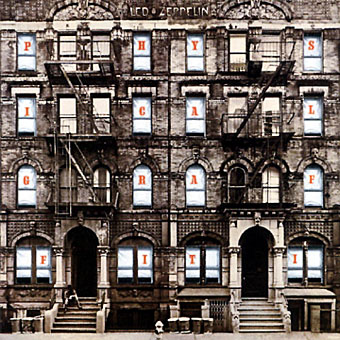
Led Zeppelin’s building is a great photograph of a New York brownstone (the original vinyl sleeve had slots cut in the windows through which the lettering and various pictures on the inner sleeves could be seen); mine had to be pieced together from separate pictures of New York in the 1930s. It doesn’t quite work because there’s not much justification for having the category lettering arranged like rows of birthday cards on the window sills. But maybe I’m being too hasty in pulling it apart when the winner won’t be announced until December 4th. Until then you can browse the 186 other entries. I have to say that the quality of these is really exceptional, if I were one of the judges I’d have a hard time choosing only one. Most of the time I wouldn’t give a second glance to an online contest but this one was fun and the high standard of the other entries has made it worthwhile.
The Brothers Quay on DVD
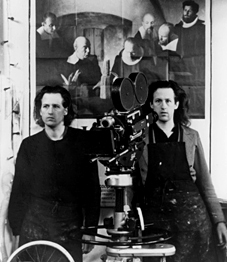
A very welcome release, these are some of my favourite films (I reviewed Street of Crocodiles for Horror: the Definitive Guide to the Cinema of Fear earlier this year). Most of the early ones can be found on the Region 1 release from Kino International but that collection is poorly transferred and the interface has a fault that renders it almost unusable on a computer. The supplementary material on this new collection seems especially good.
Quay Brothers – The Short Films 1979-2003
UK 1979-2003. Dir Quay Brothers. Colour and b&w. cert 12
Disc 1: 134 mins + 60 mins commentary Disc 2: 121 mins. Ratio 1.33:1
Buy now on DVD (£24.99)The BFI has collaborated with the inimitable Quay Brothers to release a truly comprehensive compilation of their short films on DVD; a world first. The Quays were extensively involved with the preparation of the DVD, personally supervising the transfers, recording commentaries on selected titles, and contributing an exclusive 20-minute illustrated video interview.
This two-disc set, in deluxe packaging, collects 13 of the Quay Brothers’ short films, spanning 24 years, in brand new restored and re-mastered editions (six of them with new Quay commentaries), plus a collection of ‘footnotes’ including interviews, alternative versions, unrealised pilot projects and more. An accompanying illustrated colour booklet features an encyclopaedic guide to the Quays’ universe, plus the original illustrated treatment for their best-known film Street of Crocodiles.
Born in Philadelphia and based in London, but with a creative sensibility derived from the remoter corners of Eastern Europe, identical twin animators the Quay Brothers have produced a unique body of work, and have also made a major contribution towards establishing the puppet film as a serious adult art form.
Filtering a huge range of literary, musical, cinematic and philosophical influences through their own utterly distinctive sensibility, each Quay film is a dialogue-free and usually non-narrative experience, riveting the attention through hypnotic control of décor, music and movement. With a grasp of the uncanny that rivals Luis Buñuel and Lewis Carroll, their films evoke half-remembered dreams and long-suppressed childhood memories, fascinating and deeply unsettling by turns.
The collection ranges from their very first puppet film Nocturna Artificialia (1979) to the recent The Phantom Museum (2003). In between there are all the classics: The Cabinet of Jan Svankmajer (1984), a tribute to their great Czech counterpart; This Unnameable Little Broom (1985), a reduction of the Epic of Gilgamesh into a ten-minute frenzy; their acknowledged masterpiece Street of Crocodiles (1986), a visualisation of the labyrinthine world of Polish author Bruno Schulz; the tantalisingly suggestive Rehearsals for Extinct Anatomies (1987) and The Comb (1990); the playful documentary Anamorphosis (1991), uncovering hidden meanings in outwardly conventional paintings; the Stille Nacht quartet (1988-94) of twisted music videos, and In Absentia (2000), their acclaimed collaboration with composer Karlheinz Stockhausen.
The second disc, ‘Footnotes’, contains numerous extras including a newly commissioned filmed interview, distinctive idents for the BFI and BBC2, the satirical short The Summit (1995) and a rare ‘acting’ appearance (albeit in stills) in a clip from Peter Greenaway’s The Falls.
The DVD has been produced by the BFI’s Michael Brooke, Content Developer for Screenonline, the BFI’s extensive online resource dedicated to the history of British film and television. To tie in with the release, Screenonline will be providing extensive background material for each individual title, together with a biography and filmography of the Quays.
Disc 1 – The Films
The Cabinet of Jan Svankmajer (1984)
*This Unnameable Little Broom (1985)
*Street of Crocodiles (1986)
Rehearsals for Extinct Anatomies (1987)
*Stille Nacht I – Dramolet (1988)
The Comb (1990)
Anamorphosis (1991)
*Stille Nacht II – Are We Still Married? (1992)
*Stille Nacht III – Tales From Vienna Woods (1993)
Stille Nacht IV – Can’t Go Wrong Without You (1994)
*In Absentia (2000)
The Phantom Museum (2003)
Disc 2 – Footnotes
Filmed introduction by the Quays
Nocturna Artificialia (1979)
The Calligrapher (1991)
The Summit (1995)
Archive Interview (2000)
The Falls (1980)
BFI ident
Alternative versions
*With new commentary by the Quay Brothers recorded for this DVD.
Elsewhere on { feuilleton }
• The Quay Brothers archive
Druillet meets Hodgson
French comic artist and illustrator, Philippe Druillet, illustrates British horror novelist William Hope Hodgson. As anyone familiar with Hodgson’s work knows, this kind of imagery predates Pirates of the Caribbean by nearly a century. More pictures here.
Previously on { feuilleton }
• War of the Worlds book covers
• The music of Igor Wakhévitch
• Le horreur cosmique
• Davy Jones
The art of Yayoi Kusama
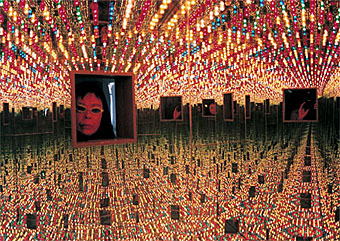
Infinity Mirror Room—Love Forever (1966/1994).
Mirror, light bulbs, stainless steel, wood.
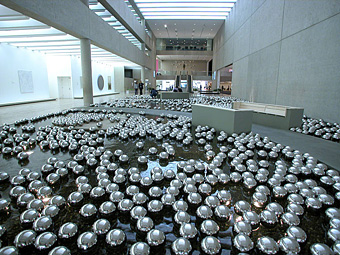
Narcissus Garden (1966/2002).
Watermall, 2000 mirror balls.
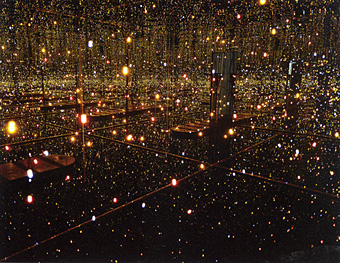
Fireflies on the Water (2002).
150 lights, mirrors and water.
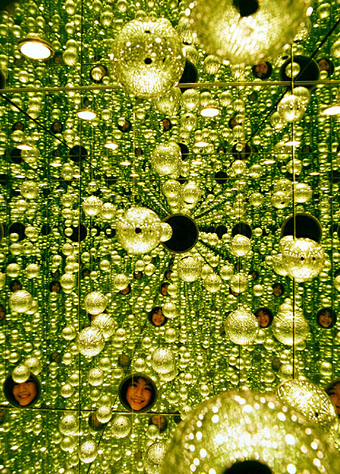
Infinity Mirror Room, Rain in Early Spring (2002).
Since the late 1950s, Yayoi Kusama has used painting, performance, sculpture, and installation to develop a highly personal formal vocabulary that combines repetitive elements such as net and dot patterns with organic and often eroticized sculptural forms. Her early paintings and collages extend the language of Abstract Expressionism and its concern for allover compositions into an intimate form of gridded space.
By the early 1960s Kusama had begun to produce her Accumulations, everyday objects such as chairs, tables, and clothes densely covered with hand-sewn, phallic protrusions. Around the same time, Kusama began to paint net and dot patterns onto household items, and in 1965 she combined all these elements in the installation Infinity Mirror Room Phalli’s Field (or Floor Show). In Infinity Mirror Room a dense field of polka-dotted phallic protrusions extended from the floor of an enclosed space. The walls of the environment were lined with mirrors, leaving only a small passageway into the center of the installation empty.
For the installation Kusama’s Peep Show (1966), the artist constructed a room whose walls and ceiling were covered with mirrors, while the floor was densely filled with glowing electric lightbulbs in different colors. Two small windows allowed the viewer and Kusama to peer inside.
Continuing her obsessive, almost psychedelic approach, the installations suggest a kaleidoscopic mode of perception, in which interior rooms contain unbound, seemingly endless spaces. By the late 1960s, Kusama began to stage performances, sometimes covering her naked body, or others’ bodies, with patterns.
In the early 1970s, Kusama returned to Tokyo; she voluntarily entered a clinic for the mentally ill, where she has remained ever since. She has continued to produce work at a prolific rate, remarkable in its consistency. Her obsessive arrangements, her often radically eroticized alterations of everyday objects, her fascination with infinity, and the all-encompassing nature of her work have remained at the core of her production.
In her most recent works Kusama continues to create reflective interior environments. Fireflies on the Water (2002) consists of a small room lined with mirrors on all sides, a pool in the center of the space, and 150 small lights hanging from the ceiling, creating a dazzling effect of direct and reflected light, emanating from both the mirrors and the water’s surface. Fireflies embodies an almost hallucinatory approach to reality, while shifting the mood from her earlier, more unsettling installations toward a more ethereal, almost spiritual experience.
More information and pictures at her site.
Previously on { feuilleton }
• Atomix by Nike Savvas

